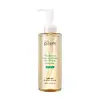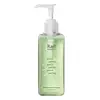What's inside
What's inside
 Key Ingredients
Key Ingredients

No key ingredients
 Benefits
Benefits

 Concerns
Concerns

 Ingredients Side-by-side
Ingredients Side-by-side

Water
Skin ConditioningGlycerin
HumectantPropanediol
SolventCocamidopropyl Hydroxysultaine
CleansingCoco-Betaine
CleansingSodium Cocoyl Isethionate
CleansingButylene Glycol
Humectant1,2-Hexanediol
Skin ConditioningDecyl Glucoside
CleansingBambusa Vulgaris Water
Skin ConditioningSaponaria Officinalis Leaf Extract
AntimicrobialCaprylic/Capric Triglyceride
MaskingSodium Chloride
MaskingLactobacillus Ferment
Skin ConditioningPolyquaternium-10
Sorbeth-30 Tetraoleate
EmulsifyingCoconut Acid
CleansingChamaecyparis Obtusa Oil
MaskingCamellia Japonica Seed Oil
EmollientOlea Europaea Fruit Oil
MaskingSodium Isethionate
CleansingCaprylyl Glycol
EmollientEthylhexylglycerin
Skin ConditioningCitric Acid
BufferingWater, Glycerin, Propanediol, Cocamidopropyl Hydroxysultaine, Coco-Betaine, Sodium Cocoyl Isethionate, Butylene Glycol, 1,2-Hexanediol, Decyl Glucoside, Bambusa Vulgaris Water, Saponaria Officinalis Leaf Extract, Caprylic/Capric Triglyceride, Sodium Chloride, Lactobacillus Ferment, Polyquaternium-10, Sorbeth-30 Tetraoleate, Coconut Acid, Chamaecyparis Obtusa Oil, Camellia Japonica Seed Oil, Olea Europaea Fruit Oil, Sodium Isethionate, Caprylyl Glycol, Ethylhexylglycerin, Citric Acid
Water
Skin ConditioningSodium Cocoyl Isethionate
CleansingGlycerin
HumectantDecyl Glucoside
CleansingLauramidopropyl Betaine
CleansingAcrylates Copolymer
Potassium Cocoyl Glycinate
Arginine
Masking1,2-Hexanediol
Skin ConditioningHydroxyacetophenone
AntioxidantDipropylene Glycol
HumectantXanthan Gum
EmulsifyingSodium Chloride
MaskingPanthenol
Skin ConditioningCaprylyl Glycol
EmollientOlea Europaea Fruit Oil
MaskingEthylhexylglycerin
Skin ConditioningSodium Hyaluronate
HumectantMelia Azadirachta Flower Extract
Skin ConditioningMelia Azadirachta Leaf Extract
Skin ConditioningButylene Glycol
HumectantOcimum Sanctum Leaf Extract
Skin ConditioningCoccinia Indica Fruit Extract
Skin ConditioningCurcuma Longa Root Extract
MaskingCorallina Officinalis Extract
Skin ConditioningPvp
Emulsion StabilisingAloe Barbadensis Flower Extract
EmollientSolanum Melongena Fruit Extract
Skin ConditioningFullerenes
AntimicrobialCitrus Nobilis Peel Oil
MaskingOcimum Basilicum Oil
MaskingLimonene
PerfumingWater, Sodium Cocoyl Isethionate, Glycerin, Decyl Glucoside, Lauramidopropyl Betaine, Acrylates Copolymer, Potassium Cocoyl Glycinate, Arginine, 1,2-Hexanediol, Hydroxyacetophenone, Dipropylene Glycol, Xanthan Gum, Sodium Chloride, Panthenol, Caprylyl Glycol, Olea Europaea Fruit Oil, Ethylhexylglycerin, Sodium Hyaluronate, Melia Azadirachta Flower Extract, Melia Azadirachta Leaf Extract, Butylene Glycol, Ocimum Sanctum Leaf Extract, Coccinia Indica Fruit Extract, Curcuma Longa Root Extract, Corallina Officinalis Extract, Pvp, Aloe Barbadensis Flower Extract, Solanum Melongena Fruit Extract, Fullerenes, Citrus Nobilis Peel Oil, Ocimum Basilicum Oil, Limonene
Ingredients Explained
These ingredients are found in both products.
Ingredients higher up in an ingredient list are typically present in a larger amount.
1,2-Hexanediol is a synthetic liquid and another multi-functional powerhouse.
It is a:
- Humectant, drawing moisture into the skin
- Emollient, helping to soften skin
- Solvent, dispersing and stabilizing formulas
- Preservative booster, enhancing the antimicrobial activity of other preservatives
Butylene Glycol (or BG) is used within cosmetic products for a few different reasons:
Overall, Butylene Glycol is a safe and well-rounded ingredient that works well with other ingredients.
Though this ingredient works well with most skin types, some people with sensitive skin may experience a reaction such as allergic rashes, closed comedones, or itchiness.
Learn more about Butylene GlycolCaprylyl Glycol is a humectant and emollient, meaning it attracts and preserves moisture.
It is a common ingredient in many products, especially those designed to hydrate skin. The primary benefits are retaining moisture, skin softening, and promoting a healthy skin barrier.
Though Caprylyl Glycol is an alcohol derived from fatty acids, it is not the kind that can dry out skin.
This ingredient is also used as a preservative to extend the life of products. It has slight antimicrobial properties.
Learn more about Caprylyl GlycolDecyl Glucoside is a glucose-based surfactant and emulsion stabilizer. It is created by reacting glucose with the fatty acids from plants.
Surfactants help clean the skin by trapping oil, sebum, and dirt to be washed away. As an emulsion stabilizer, it stabilizes the ingredients in a product by preventing them from separating.
This ingredient is biodegradable and non-toxic. This ingredient is commonly found in baby shampoos.
Decyl Glucoside is sometimes used to stabilize the UV filter Tinosorb.
Learn more about Decyl GlucosideEthylhexylglycerin (we can't pronounce this either) is commonly used as a preservative and skin softener. It is derived from glyceryl.
You might see Ethylhexylglycerin often paired with other preservatives such as phenoxyethanol. Ethylhexylglycerin has been found to increase the effectiveness of these other preservatives.
Glycerin is already naturally found in your skin. It helps moisturize and protect your skin.
A study from 2016 found glycerin to be more effective as a humectant than AHAs and hyaluronic acid.
As a humectant, it helps the skin stay hydrated by pulling moisture to your skin. The low molecular weight of glycerin allows it to pull moisture into the deeper layers of your skin.
Hydrated skin improves your skin barrier; Your skin barrier helps protect against irritants and bacteria.
Glycerin has also been found to have antimicrobial and antiviral properties. Due to these properties, glycerin is often used in wound and burn treatments.
In cosmetics, glycerin is usually derived from plants such as soybean or palm. However, it can also be sourced from animals, such as tallow or animal fat.
This ingredient is organic, colorless, odorless, and non-toxic.
Glycerin is the name for this ingredient in American English. British English uses Glycerol/Glycerine.
Learn more about GlycerinOlea Europaea Fruit Oil is the fixed oil obtained from the ripe fruit of the Olive. In other words - olive oil.
The primary contents of olive oil are glycerides of the fatty acids linoleic, oleic and palmitic.
Olive oil also contains antioxidants such as Vitamin E. Antioxidants may help reduce signs of aging by fighting unstable free-radical molecules. It also contains Vitamins A (retinol), D, and K.
The squalene in olive oil makes it a great emollient. Emollients help soothe and soften your skin by trapping moisture in. This makes olive oil a great skin moisturizer.
Studies show olive oil to have antibacterial and antifungal properties in low concentrations. Another study found olive oil irritated sensitive oily skin. We always recommend speaking with a professional about using this ingredient in your routine.
Due to the fatty acid content, this ingredient may not be fungal-acne safe.
Learn more about Olea Europaea Fruit OilChances are, you eat sodium chloride every day. Sodium Chloride is also known as table salt.
This ingredient has many purposes in skincare: thickener, emulsifier, and exfoliator.
You'll most likely find this ingredient in cleansers where it is used to create a gel-like texture. As an emulsifier, it also prevents ingredients from separating.
There is much debate on whether this ingredient is comedogenic. The short answer - comedogenic ratings don't tell the whole story. Learn more about comegodenic ratings here.
The concensus about this ingredient causing acne seems to be divided. Research is needed to understand if this ingredient does cause acne.
Scrubs may use salt as the primary exfoliating ingredient.
Learn more about Sodium ChlorideSodium cocoyl isethionate is a natural ingredient from coconut oil. It is an ultra gentle cleanser that gives a nice foam without drying the skin or impacting the skin barrier.
The amount of foam created depends on the amount of sodium cocoyl isethionate used in the product.
This ingredient also helps improve the spreadability of a product.
Learn more about Sodium Cocoyl IsethionateWater. It's the most common cosmetic ingredient of all. You'll usually see it at the top of ingredient lists, meaning that it makes up the largest part of the product.
So why is it so popular? Water most often acts as a solvent - this means that it helps dissolve other ingredients into the formulation.
You'll also recognize water as that liquid we all need to stay alive. If you see this, drink a glass of water. Stay hydrated!
Learn more about Water